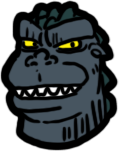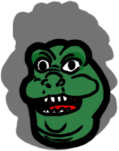The Mightiest Monster in All Creation!
Ravishing a universe for love!
Ravishing a universe for love!
Want more Kaiju-related reviews? Check these out!
Movie: Mothra also know as Mosura (モスラ)
Directed by Ishirō Honda
Release date 1961
Genre Science-fiction/fantasy/adventure film/Kaiju
Country Japan
Following the success of King Kong in 1933 and the success of the original Godzilla in 1954, an entire new cinematographic genre was launched in the wake of the 1950s which helped revive an interest in creature features in both Japan and the USA.
Kaiju films, aka "daikaiju" feature films, which was an offshoot genre of the Japanese tokusatsu genre focused on giant monsters - Japan's own B-movie trend to blend sci-fi/fantasy and horror (originally). The monsters were often ancient creatures awaken by mankind's mistakes. Reclaiming the world from us, humans. Unstoppable forces.
Following Godzilla's success a lot of these were imported worldwide, in small theaters and through TV including the Gamera film series or TV serials such as Kamen Rider and Ultraman.
Following the success of Godzilla, Toho Studios would launch several other new giant monsters.
If Godzilla could be seen as Japan's answer to The Beast from 20,000 Fathoms, Mothra was their direct answer to the original 1933 King Kong film.
The film was directed by Godzilla creator himself and genre regular Ishirō Honda, with his partner on special effects Eiji Tsuburaya.
While Godzilla was closer in tone to science-fiction/horror films, Mothra is more of a fantasy/adventure film.
The story begins in the middle of a typhoon in high waters in-between Japan and the fictive country of Rolisica. A sort of amalgam of the US and Russia, the later final act of the film taking place in its fictive city of New Kirk City, a New York-look alike filled a lot of western actors. Their soldier's uniforms looking very much like soviet uniforms, and people speaking English over there (but apparently also clearly understanding Japanese).
Several nuclear tests were run over those seas, back then.
Long story short, a bunch of survivors are found ship wrecked on Infant Island. People feared they would succumb to the radioactive fallout post-WWII... but they are mysteriously not suffering any lasting radiation issue...!?
Since this took place around their waters, the Rolisican government funds Japanese expedition to go study the situation over there.
We met Zenichiro Fukuda, aka "the snapping turtle", a reporter and his photographer Michi Hanamura who try to get aboard the expedition. The expedition is led by Shinichi Chujo, a linguist/anthropologist present here to talk with the supposedly natives the ship-wrecked survivors met. But they have to report to a Clark Nelson, a Rolisican businessman who is put in charge of the operation.
They find strange mutated local fauna, but no traces of radiation. Finally they find instead six inch-tall twin sisters. But the natives force them to leave the place, and they leave it at that...
... that is until Nelson returns there discretely with thugs, kidnaps the twins and decides to put a show to show the entire world his discovery! These "Secret Fairies" are deemed "not human" and so he can do as he pleases with these creatures. He starts displaying them on stage for his own greed.
But the rest of the expedition members are not really pleased with this turn of events. Chujo also found some strange symbols on the island, mentioning a guardian creature named "Mothra"...
Meanwhile a giant egg on the island hatches... and a giant monsterous caterpillar creature emerges from it!
Mothra is coming! It's swimming towards Japan to save the two girls. The creature survives a napalm attack and the military military. It goes through a boat, anything in his patch, really, until it finally reaches Japan!!
The fairies continue to sing from their cage, guiding Mothra after them. Mothra apparently is linked via telepathy to them. They try blocking the signal with a protection.
The military finally apparently dispatches Mothra near the Tokyo Tower. It forms a cocoon and goes dormant...
.. but it's not over yet! The army employs an Atomic Heat Cannon to kill the beast for good... helping Mothra emerge from it in a new adult butterfly form!
Nelson and his goons go to Rolisica, making Mothra leave Japan to go after them over there as well. Mothra wrecks havoc in the city...
Will our heroes be able to calm the creature in time to prevent if from destroying an entire country!?
It's a pretty fun and decent plot. While it's nothing new really, it's at least fairly cohesive and straightforward enough.
Mothra has a more mystical angle, a magical approach to giant monsters, than Godzilla ever had.
While Godzilla was presented as the legendary King of All Monsters, a force of nature to reckon with, Mothra is presented here instead as a deity. Beloved by the ones it protects.
A more fantasy tone that almost brings it back to its roots.
The entire film and its story are pretty close to the original King Kong. This was no doubt Ishirō Honda's attempt to do a proper tribute to King Kong, where Godzilla had actually taken a much different darker route at the end of the day.
The special effects look actually pretty good for the time. There's some nice cinematography to Mothra. Great FXs and miniature sets.
Unlike Godzilla, this film was directly shot in color this time. There's a lot of great composition shots. Mothra looks stunning in both his larva an butterfly forms.
A Lovely use of camera work and great colors & contrasts. The ship attack looks great for the time, incredible work all around.
There's also some great ground-level shots of Mothra as a larva, something usually more unique to the Gamera series rather than Toho's side of Kaiju films.
Mothra is a fun movie, in which the Kaiju doesn't entirely appear as bad. It only acts as a good monster while actually trying to get after the fairies.
The cast was also particularly good for once.
There's a lot of humor in Mothra. Our "snapping turtle" Fukuda is played by a great fun actor and popular Japanese comedian Frankie Sakai. We also get a fantastic evil villain in Jerry Ito. Finally there's even a lot of westerner actors thrown in the mix, which give Mothra a more international vibe, fitting what with the political tensions in the scenario.
Mothra was released in theaters in Japan in 1961, it would take only another year for Mothra to reach the US in its release in 1962 (more on that below). The film did really well back in the day, both in Japan and worldwide.
Finally the film counts on a fantastic score composed by Yuki Koseki. Epic at times and including what has since become probably one of the most enduring and memorable songs of the entire Kaiju genre over the decades - Mothra's song!
Overall, Mothra is a stunning classic old school film.
It's very much more of an adventure film, which give Mothra a definitively different tone from the rest. It's also very colorful.
Sony finally re-released as part of the Icons Of Sci Fi: Toho compilation all above. A pack which includes both the original Japanese and edited English releases of the following Toho films: Mothra (1961), Battle In Outer Space (1959)" & The H-Man (1958) - all directed by Honda.
Back in the day, the US cut was slightly edited - though nothing like Godzilla in comparison. The cut mostly edited out about 10 minutes of the plot.
Mothra has since then become one of the most popular Toho monsters. A classic.
The basic plot would later be mostly recycled in/inspiring King Kong vs. Godzilla and Mothra vs. Godzilla (from 1962 and 1964 respectively, both also written by Shinichi Sekizawa).
Mothra was finally revived in the 1990s in a new trilogy of films. Having killed off Godzilla (while Americans would be trying to launch their own remake of the King of All Monsters), Toho decided to focus back on other long-running well-established creatures which gave us the film Rebirth of Mothra in 1996.
I give it:



2.5 / 3 Gojiras!








No comments:
Post a Comment